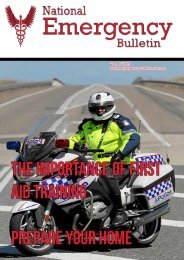National Emergency Magazine Vol. 4 2014
Create successful ePaper yourself
Turn your PDF publications into a flip-book with our unique Google optimized e-Paper software.
Australian Crime<br />
Facts and Figures<br />
While the volume and rate<br />
of individual crime types has<br />
fluctuated over the past few<br />
years, overall, crime in Australia<br />
has been decreasing. Australian<br />
Crime: Facts & Figures uses<br />
information compiled from a<br />
broad range of sources to create<br />
an accurate and holistic picture<br />
of crime and criminal justice<br />
issues in Australia. Within this<br />
volume are the patterns and<br />
trends relating to specific crimes,<br />
victims, offenders, the location of<br />
criminal acts and the operation<br />
and cost of the criminal justice<br />
system (including the police,<br />
courts and prisons). The purpose<br />
of this publication is to provide<br />
government and justice agencies,<br />
the media and the Australian<br />
public with accurate, easy to<br />
access crime statistics in a single,<br />
centralised location.<br />
Property crime<br />
• Property crime continued to<br />
be reported at a much higher<br />
volume than violent crime in<br />
2012. While there were statistically<br />
small changes in ‘other’ theft<br />
and unlawful entry with intent,<br />
following a small increase<br />
This publication utilises data<br />
from both administrative and<br />
survey-based collections<br />
Foreword<br />
in motor vehicle theft in 2011, the<br />
six percent increase in the number<br />
of victims of motor vehicle theft<br />
in 2012 (from 55,310 in 2011 to<br />
58,574 in 2012) is the greatest<br />
percentage increase on record for<br />
the last 10 years.<br />
Financial crime<br />
• Overall, while fraud committed<br />
on credit and charge cards<br />
decreased by 17 percent between<br />
2011 and 2012—a decrease of<br />
16.78 cents per $1,000 transacted,<br />
these types of fraud have generally<br />
increased since 2006, increasing<br />
from 37.93 cents per $1,000<br />
transacted in 2006 to 79.26 cents<br />
per $1,000 transacted in 2012.<br />
• Scams aim to defraud an<br />
individual through deception.<br />
The Australian Competition and<br />
Consumer Commission monitors<br />
the level of scam activity. The<br />
top 10 scams reported to the<br />
Australian Competition and<br />
Consumer Commission in 2012<br />
involved:<br />
– advance fee/upfront payment;<br />
– computer hacking (including<br />
malware and viruses);<br />
– lottery and sweepstakes;<br />
– banking and online account<br />
(including phishing and identity<br />
theft); – online auction and<br />
shopping (including classifieds);<br />
– unexpected prizes;<br />
– job and employment (including<br />
business opportunity);<br />
– false billing;<br />
– dating and romance (including<br />
adult services); and<br />
– mobile phone (including<br />
ringtones, competitions and<br />
missed calls).<br />
• The proportion of reported<br />
scams involving advance fee/<br />
upfront payment scams decreased<br />
by five percentage points between<br />
2011 and 2012, while computer<br />
hacking decreased by 10<br />
percentage points.<br />
• Conversely, the proportion<br />
of scams involving lottery and<br />
sweepstakes, banking and online<br />
accounts, online auction and<br />
shopping, and unexpected prizes<br />
increased between 2011 and 2012.<br />
Drugs<br />
• The number of amphetamine<br />
arrests peaked in 2011–12 at<br />
16,828, a 30 percent increase on<br />
the previous year and consistent<br />
with an overall increase in use<br />
since 1996–97.<br />
iv Australian crime: Facts &<br />
figures 2013<br />
• Cannabis has accounted for the<br />
highest volume of drug arrests<br />
since 1996–97. In 2011–12, there<br />
were 61,011 drug arrests involving<br />
cannabis, a 12 percent decrease<br />
on that recorded in 1996–97.<br />
However, since 2007–08, the<br />
number of cannabis- related<br />
arrests has been increasing by<br />
approximately three percent per<br />
year.<br />
• The number of cocaine arrests<br />
peaked in 2009–10 at 1,244.<br />
The 2011–12 figure (n=995)<br />
represented a 19 percent increase<br />
on the previous year, but is still<br />
20 percentage points below the<br />
2009–10 peak in arrests.<br />
• Between 1998–99 and 2001–02,<br />
the number of heroin-related drug<br />
arrests decreased from 14,341 to<br />
3,259—a total percentage decrease<br />
of 77 percent. In 2011–12, there<br />
were 2,714 heroin-related arrests.





